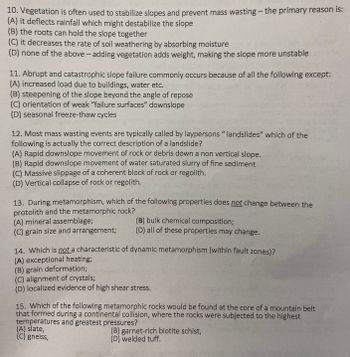
Applications and Investigations in Earth Science (9th Edition)
9th Edition
ISBN: 9780134746241
Author: Edward J. Tarbuck, Frederick K. Lutgens, Dennis G. Tasa
Publisher: PEARSON
expand_more
expand_more
format_list_bulleted
Question

Transcribed Image Text:10. Vegetation is often used to stabilize slopes and prevent mass wasting - the primary reason is:
(A) it deflects rainfall which might destabilize the slope
(B) the roots can hold the slope together
(C) it decreases the rate of soil weathering by absorbing moisture
(D) none of the above-adding vegetation adds weight, making the slope more unstable
11. Abrupt and catastrophic slope failure commonly occurs because of all the following except:
(A) increased load due to buildings, water etc.
(B) steepening of the slope beyond the angle of repose
(C) orientation of weak "failure surfaces" downslope
(D) seasonal freeze-thaw cycles
12. Most mass wasting events are typically called by laypersons " landslides" which of the
following is actually the correct description of a landslide?
(A) Rapid downslope movement of rock or debris down a non vertical slope.
(B) Rapid downslope movement of water saturated slurry of fine sediment
(C) Massive slippage of a coherent block of rock or regolith.
(D) Vertical collapse of rock or regolith.
13. During metamorphism, which of the following properties does not change between the
protolith and the metamorphic rock?
(A) mineral assemblage;
(C) grain size and arrangement;
(B) bulk chemical composition;
(D) all of these properties may change.
14. Which is not a characteristic of dynamic metamorphism (within fault zones)?
(A) exceptional heating;
(B) grain deformation;
(C) alignment of crystals;
(D) localized evidence of high shear stress.
15. Which of the following metamorphic rocks would be found at the core of a mountain belt
that formed during a continental collision, where the rocks were subjected to the highest
temperatures and greatest pressures?
(A) slate,
(C) gneiss,
(B) garnet-rich biotite schist,
(D) welded tuff.
Expert Solution
This question has been solved!
Explore an expertly crafted, step-by-step solution for a thorough understanding of key concepts.
This is a popular solution
Trending nowThis is a popular solution!
Step by stepSolved in 2 steps

Knowledge Booster
Recommended textbooks for you
 Applications and Investigations in Earth Science ...Earth ScienceISBN:9780134746241Author:Edward J. Tarbuck, Frederick K. Lutgens, Dennis G. TasaPublisher:PEARSON
Applications and Investigations in Earth Science ...Earth ScienceISBN:9780134746241Author:Edward J. Tarbuck, Frederick K. Lutgens, Dennis G. TasaPublisher:PEARSON Exercises for Weather & Climate (9th Edition)Earth ScienceISBN:9780134041360Author:Greg CarbonePublisher:PEARSON
Exercises for Weather & Climate (9th Edition)Earth ScienceISBN:9780134041360Author:Greg CarbonePublisher:PEARSON Environmental ScienceEarth ScienceISBN:9781260153125Author:William P Cunningham Prof., Mary Ann Cunningham ProfessorPublisher:McGraw-Hill Education
Environmental ScienceEarth ScienceISBN:9781260153125Author:William P Cunningham Prof., Mary Ann Cunningham ProfessorPublisher:McGraw-Hill Education Earth Science (15th Edition)Earth ScienceISBN:9780134543536Author:Edward J. Tarbuck, Frederick K. Lutgens, Dennis G. TasaPublisher:PEARSON
Earth Science (15th Edition)Earth ScienceISBN:9780134543536Author:Edward J. Tarbuck, Frederick K. Lutgens, Dennis G. TasaPublisher:PEARSON Environmental Science (MindTap Course List)Earth ScienceISBN:9781337569613Author:G. Tyler Miller, Scott SpoolmanPublisher:Cengage Learning
Environmental Science (MindTap Course List)Earth ScienceISBN:9781337569613Author:G. Tyler Miller, Scott SpoolmanPublisher:Cengage Learning Physical GeologyEarth ScienceISBN:9781259916823Author:Plummer, Charles C., CARLSON, Diane H., Hammersley, LisaPublisher:Mcgraw-hill Education,
Physical GeologyEarth ScienceISBN:9781259916823Author:Plummer, Charles C., CARLSON, Diane H., Hammersley, LisaPublisher:Mcgraw-hill Education,

Applications and Investigations in Earth Science ...
Earth Science
ISBN:9780134746241
Author:Edward J. Tarbuck, Frederick K. Lutgens, Dennis G. Tasa
Publisher:PEARSON

Exercises for Weather & Climate (9th Edition)
Earth Science
ISBN:9780134041360
Author:Greg Carbone
Publisher:PEARSON

Environmental Science
Earth Science
ISBN:9781260153125
Author:William P Cunningham Prof., Mary Ann Cunningham Professor
Publisher:McGraw-Hill Education

Earth Science (15th Edition)
Earth Science
ISBN:9780134543536
Author:Edward J. Tarbuck, Frederick K. Lutgens, Dennis G. Tasa
Publisher:PEARSON

Environmental Science (MindTap Course List)
Earth Science
ISBN:9781337569613
Author:G. Tyler Miller, Scott Spoolman
Publisher:Cengage Learning

Physical Geology
Earth Science
ISBN:9781259916823
Author:Plummer, Charles C., CARLSON, Diane H., Hammersley, Lisa
Publisher:Mcgraw-hill Education,